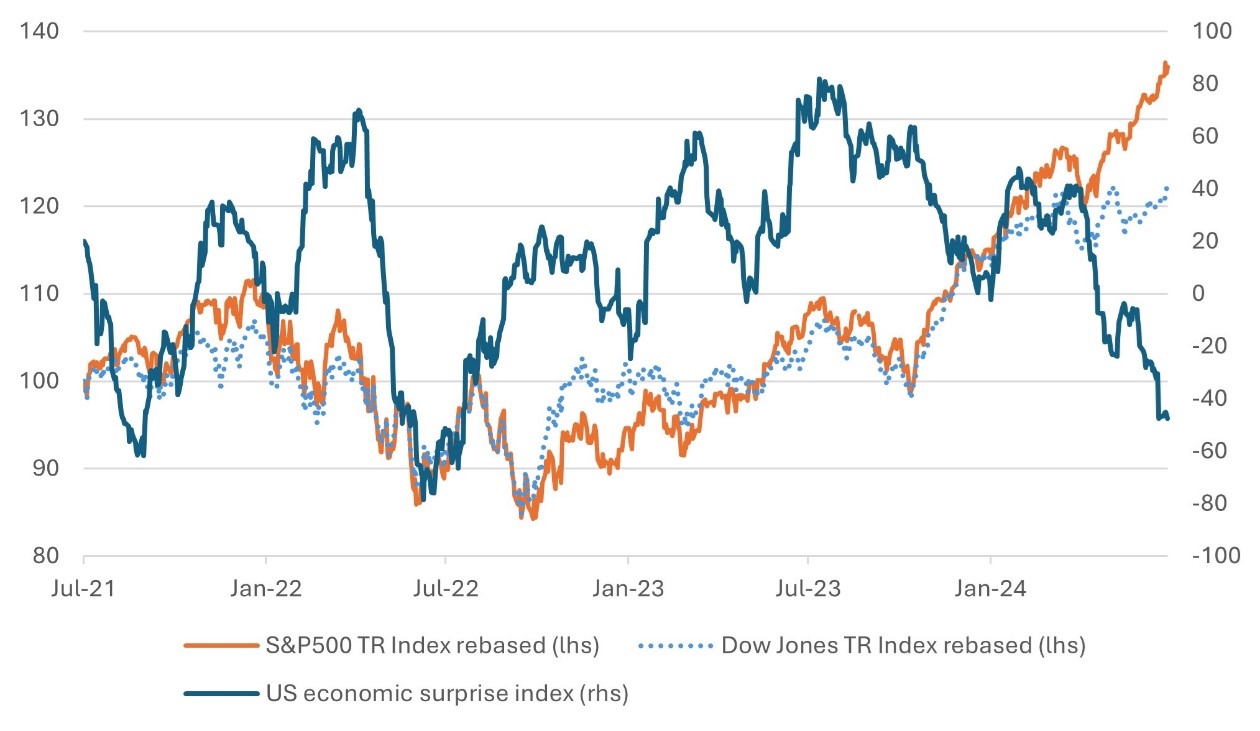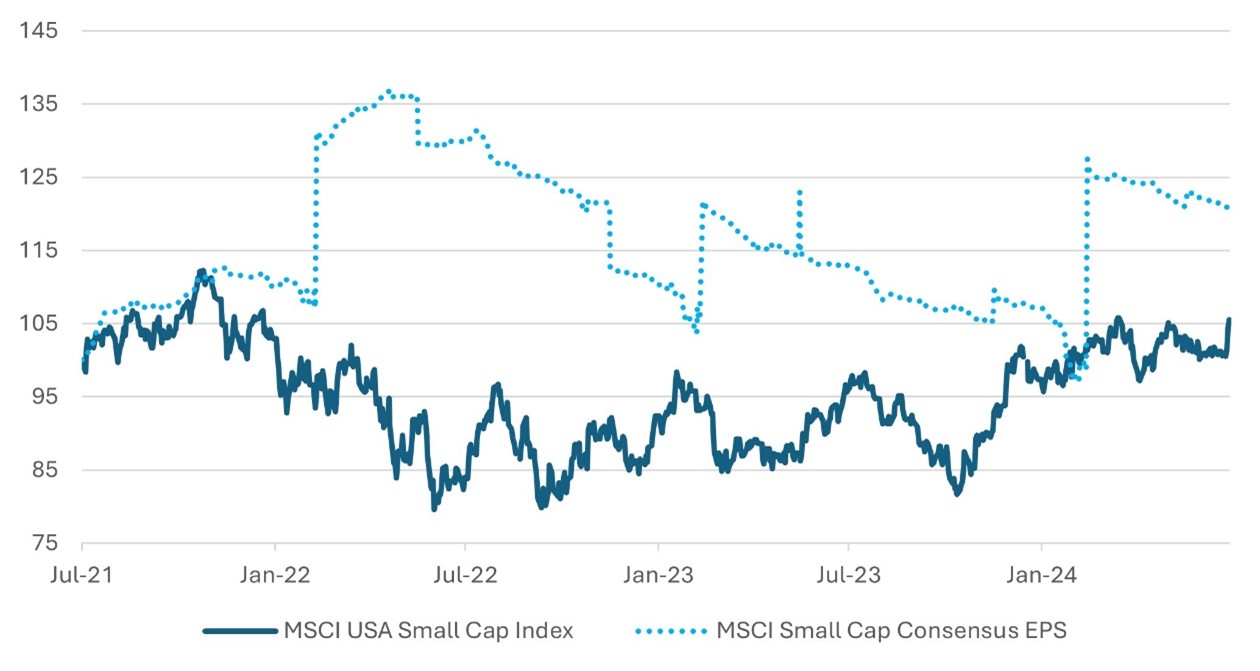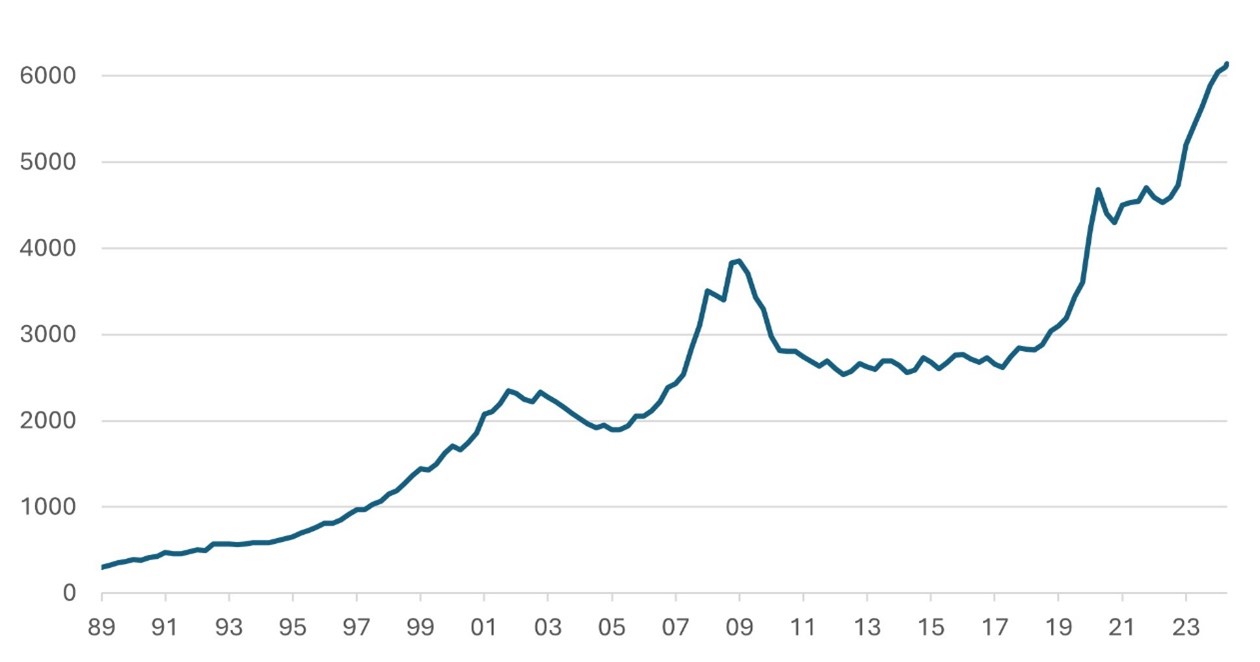By Falco
15 Jul 2024
• Good US inflation report increases hopes for a rate cut no later than in September
• US Core CPI has fallen to 2.1% in Q2 from 4.2% in Q1
• The prospect of a rate cut should help equities hold up despite weaker-than-expected growth data
• Equity market rotation into interest rate-sensitives and small caps under way and likely to continue
• Record levels of money market assets indicative of potential buying power for risk assets as interest rates fall
The Fed pivoting from its earlier stance of three rate cuts to just one over the balance of the year has proven misguided. Contrary to the central bank’s indications at its last FOMC meeting, the market is now preparing for earlier rate cuts, with at least two anticipated by year-end.
Economic and Inflation Trends
As shown below, recent data suggests a slowdown in both the US economy and inflation:
Despite these positive inflation indicators, there are arguments against an immediate rate cut at the Fed's next meeting on July 30-31. Nevertheless, there are some solid arguments, too, for the Fed to cut interest rates at its July 30-31 meeting; however, the optics might not look good. At the last FOMC meeting the Fed built a case for the market to expect fewer rate cuts, not more; secondly, the PCE inflation report for technical reasons may not show the same degree of progress on bringing inflation under control; and thirdly, wage inflation may be slower to moderate.Hence, although it may be a bit early to expect a rate cut in the July meeting, the central bank could still use the coming weeks running up to its September meeting to indicate that it is currently much more comfortable with the inflation outlook. A September rate cut would then look like a done deal.
Economic Stress and Market Reaction
The US economy is showing signs of stress. The US economic surprise index, which measures how economic data compares with expectations, has dropped to its lowest level in two years. However, unlike in mid-2022, the financial market’s reaction this time has been notably different. In 2022, economic growth was underperforming while inflation was accelerating, forcing the Fed to raise rates sharply back then, which led to a significant equity market correction. Currently, the Fed might be falling behind in cutting rates. The market is betting, and the Fed is hinting, that they will adjust their expectations to allow for at least two rate cuts by year-end, with the first cut likely in September.
Chart 1: US Economic Surprise Index at its Lowest Since 2022 but Equities Rise

Source: Bloomberg
Equity Market Rally
The equity markets have rallied in response, with old economy stocks outperforming tech, and small-cap indices showing significant improvements. For example, the MSCI US small cap index, which had been flat over the past three years, saw a sharp rally last Friday, suggesting further upside potential. Over the past four years, the small cap index has seen a drop in valuation; although the earnings index for small caps has risen 20%, the index has returned very little. In our view, there is room here for a further run up in the small cap index to close the gap with earnings.
Chart 2: US Small Cap Rally Supported by Valuation

Source: Bloomberg
US Economic Outlook and Risks
The outlook for the US economy remains mixed. While some economists and strategists warn of recession risks and potential equity market corrections, factors such as low unemployment, improving small company confidence, and supportive government spending make a prolonged economic downturn less likely.
Long-Term Interest Rate Challenges
A major long-term challenge lies in the realization of what we consider ‘normal’ interest rates, which will be higher than those seen since the tech bust and the global financial crisis. Many assume that 'normal' rates are negative real rates, but they tend to ignore the fact that positive real rates imply higher interest rates for a given level of inflation. Additionally, rebuilding proper risk premiums in some credit markets is crucial. Mohit Mittal, one of PIMCO's CIOs, recently noted that the excess premium for less-liquid investments has dropped below 100 basis points, less than half of what it should be. This re-pricing of credit lines with less liquidity is more likely to drive a downward re-pricing of risk assets than just a few months of weaker economic data.
Money Market Fund Assets
One supporting factor for risk assets is the substantial amount of money lying in money market funds that could be redirected to equity markets as interest rates fall. Over the past week, total money market fund assets rose by $40.9 billion to a record $6.14 trillion, up 8.1% year-to-date and 13.1% year-over-year.
Chart 3: Total Money Market Assets ($bn)

Source: Bloomberg
Gary Dugan - Investment Committee Member
Bill O'Neill - Non-Executive Director & Investor Committee Chairman
15th July 2024
The information contained within is for educational and informational purposes ONLY. It is not intended nor should it be considered an invitation or inducement to buy or sell a security or securities noted within nor should it be viewed as a communication intended to persuade or incite you to buy or sell security or securities noted within. Any commentary provided is the opinion of the author and should not be considered a personalised recommendation. The information contained within should not be a person's sole basis for making an investment decision. Please contact your financial professional at Falco Private Wealth before making an investment decision. Falco Private Wealth are Authorised and Regulated by the Financial Conduct Authority. Registered in England: 11073543 at Millhouse, 32-38 East Street, Rochford, Essex SS4 1DB
